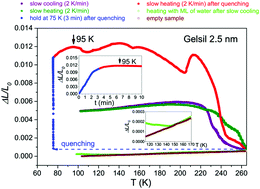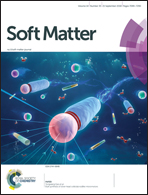DMA study of water's glass transition in nanoscale confinement
Abstract
Dynamic mechanical analysis (DMA) measurements of water confined in nanoporous silica have been performed as a function of temperature and frequency for different pore sizes (2.5–10 nm) at heating and cooling. Most of the data show three processes, P1, P2 and P3, where P1 and P2 depend on measurement frequency and P3 does not. The characteristic shift of P3 with pore size shows that this process corresponds to freezing/melting of “internal water”, i.e. in the core of the pores. Thermal expansion data indicate – in agreement with e.g. [A. Taschin, P. Bartolini and R. Torre, Meas. Sci. Technol., 2017, 28, 014009] – that in all our nanoporous systems about 2 layers of water remain liquid much below the freezing point. Dynamic elastic measurements show clear signatures of glass freezing of this supercooled water in the vicinity of P1. Extrapolating the DMA data to the timescale (103 s) of adiabatic calorimetry unveils a systematic behaviour: P1(T) shows a clear size dependence for a broad range of pore diameters, i.e. 2.5 nm ≤ d ≤ 52 nm, implying (together with the corresponding activation energy 0.5 eV) that P1 corresponds to the glass–liquid transition of a few layers of supercooled water at Tg(d). An extrapolation of Tg(d) to d → ∞ yields Tg(∞) ≈ 136 K, the traditional value for bulk water. The small (liquid like) value of Young's modulus in a temperature region above P1 is most naturally explained assuming that the supercooled water in this range is still liquid, implying that Tg values of 160 K or even 210 K – as suggested by various authors – are unlikely.



 Please wait while we load your content...
Please wait while we load your content...